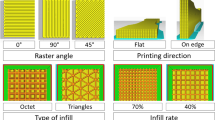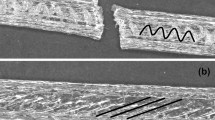Abstract
3D printing has gained great popularity due to its main feature of manufacturing complex geometries. The building process by adding successive layers generates mechanical properties that depend on the printing parameters, where build orientation is one of the most relevant factors. Due to this, the characterization of the mechanical response of these pieces is a challenging task of practical importance to estimate their lifespan. The aim of this study is to characterize the mechanical behavior and define a 3D constitutive model of polymer materials commonly used in 3D printing manufacturing. Hence, ABS and PLA were used with a low-cost desktop printer with which specimens were manufactured in two orthogonal orientations: flat and upright. Tensile and compression tests were performed to this end, where the Young’s modulus, yield, and maximum stresses were determined. In the tensile tests, the samples with vertical (upright) orientation showed lower values in the evaluated mechanical properties than the corresponding to the horizontal (flat) orientation. However, no significant difference caused by the printing orientations was observed in the compression tests. Different values of Young’s modulus and maximum strength were found between tensile and compression tests for the same material and orientation. Moreover, in order to describe the observed material response, a linear isotropic bimodular model is proposed. This constitutive model, which is fed with the previously obtained tensile and compression data, is used in the simulation of a four-point bending test where it is found to adequately represent the experimentally measured elastic behavior in the load-deflection curve. Thus, the combination of experiments and a bimodular constitutive model contributes to making better predictions of the mechanical response of structures made with 3D printing.














Similar content being viewed by others
Data availability
The raw/processed data required to reproduce these findings cannot be shared at this time due to space limitations.
References
Columbus L (2017) The state of 3D printing 2017. Retrieved August 18, 2018, from https://www.forbes.com/sites/louiscolumbus/2017/05/23/the-state-of-3d-printing-2017/#a53d4e357ebf
Chacón JM, Caminero MA, García-Plaza E, Núñez PJ (2017) Additive manufacturing of PLA structures using fused deposition modelling: effect of process parameters on mechanical properties and their optimal selection. Mater Des 124:143–157. https://doi.org/10.1016/j.matdes.2017.03.065
Fernandez-Vicente M, Calle W, Ferrandiz S, Conejero A (2016) Effect of infill parameters on tensile mechanical behavior in desktop 3D printing. 3D Printing and Additive Manufacturing 3(3):183–192. https://doi.org/10.1089/3dp.2015.0036
Khuong TL, Zhao G, Farid M, Yu R, Sun ZZ, Rizwan M (2014) Tensile strength and flexural strength testing of acrylonitrile butadiene styrene (ABS) materials for biomimetic robotic applications. Journal of Biomimetics, Biomaterials and Biomedical Engineering 20:11–21. https://doi.org/10.4028/www.scientific.net/JBBBE.20.11
Zou R, Xia Y, Liu S, Hu P, Hou W, Hu Q, Shan C (2016) Isotropic and anisotropic elasticity and yielding of 3D printed material. Compos Part B 99:506–513. https://doi.org/10.1016/j.compositesb.2016.06.009
Bertoldi M, Yardimci MA, Pistor CM, Guceri SI, Sala G (1998) Mechanical characterization of parts processed via fused deposition. Proceedings of the 1998 International Solid Freeform Fabrication Symposium. https://doi.org/10.26153/tsw/646
Croccolo D, De Agostinis M, Olmi G (2013) Experimental characterization and analytical modelling of the mechanical behaviour of fused deposition processed parts made of ABS-M30. Comput Mater Sci 79:506–518. https://doi.org/10.1016/j.commatsci.2013.06.041
Domingo-Espin M, Puigoriol-Forcada JM, Garcia-Granada AA, Llumà J, Borros S, Reyes G (2015) Mechanical property characterization and simulation of fused deposition modeling Polycarbonate parts. Mater Des 83:670–677. https://doi.org/10.1016/j.matdes.2015.06.074
Es-Said OS, Foyos J, Noorani R, Mendelson M, Marloth R, Pregger BA (2000) Effect of layer orientation on mechanical properties of rapid prototyped samples. Mater Manuf Process 15(1):107–122. https://doi.org/10.1080/10426910008912976
Hernandez R, Slaughter D, Whaley D, Tate J, Asiabanpour B (2016) Analyzing the tensile, compressive, and flexural properties of 3D printed ABS P430 plastic based on printing orientation using fused deposition modeling. In: Proceedings of the 27th annual international solid freeform fabrication symposium, pp 939–950
Hill N, Haghi M (2014) Deposition direction-dependent failure criteria for fused deposition modeling polycarbonate. Rapid Prototyp J 20(3):221–227. https://doi.org/10.1108/RPJ-04-2013-0039
Lanzotti A, Grasso M, Staiano G, Martorelli M (2015) The impact of process parameters on mechanical properties of parts fabricated in PLA with an open-source 3-D printer. Rapid Prototyp J 21(5):604–617. https://doi.org/10.1108/RPJ-09-2014-0135
Li L, Sun Q, Bellehumeur C, Gu P (2002) Composite modeling and analysis for fabrication of FDM prototypes with locally controlled properties. J Manuf Process 4(2):129–141. https://doi.org/10.1016/S1526-6125(02)70139-4
Montero M, Roundy S, Odell D (2001) Material characterization of fused deposition modeling (FDM) ABS by designed experiments. Soc Manuf Eng 1–21
Rodríguez J, Thomas J, Renaud J (2001) Mechanical behavior of acrylonitrile butadiene styrene fused deposition materials modeling. Rapid Prototyp J 9(4):219–230. https://doi.org/10.1108/13552540310489604
Sood AK, Ohdar RK, Mahapatra SS (2010) Parametric appraisal of mechanical property of fused deposition modelling processed parts. Mater Des 31(1):287–295. https://doi.org/10.1016/j.matdes.2009.06.016
Torrado AR, Roberson DA (2016) Failure analysis and anisotropy evaluation of 3D-printed tensile test specimens of different geometries and print raster patterns. J Fail Anal Prev 16(1):154–164. https://doi.org/10.1007/s11668-016-0067-4
Cantrell JT, Rohde S, Damiani D, Gurnani R, DiSandro L, Anton J, Young A, Jerez A, Steinbach D, Kroese C, Ifju PG (2017) Experimental characterization of the mechanical properties of 3D-printed ABS and polycarbonate parts. Rapid Prototyp J 23(4):811–824. https://doi.org/10.1108/RPJ-03-2016-0042
Ahn SH, Montero M, Odell D, Roundy S, Wright PK (2002) Anisotropic material properties of fused deposition modeling ABS. Rapid Prototyp J 8(4):248–257. https://doi.org/10.1108/13552540210441166lee
Lee CS, Kim SG, Kim HJ, Ahn SH (2007) Measurement of anisotropic compressive strength of rapid prototyping parts. J Mater Process Technol 187–188:627–630. https://doi.org/10.1016/j.jmatprotec.2006.11.095
Sood AK, Ohdar RK, Mahapatra SS (2012) Experimental investigation and empirical modelling of FDM process for compressive strength improvement. J Adv Res 3(1):81–90. https://doi.org/10.1016/j.jare.2011.05.001
Guessasma S, Belhabib S, Nouri H, Ben Hassana O (2016) Anisotropic damage inferred to 3D printed polymers using fused deposition modelling and subject to severe compression. Eur Polym J 85:324–340. https://doi.org/10.1016/j.eurpolymj.2016.10.030
Slane J, Vivanco J, Meyer J, Squire M, Ploeg H-L (2017) Characterization of the quasi-static and viscoelastic properties of orthopaedic bone cement at the macro and nanoscale. J Biomed Mater Res B Appl Biomater 105(6):1461–1468. https://doi.org/10.1002/jbm.b.33687
Slane J, Vivanco J, Meyer J, Ploeg H-L, Squire M (2014) Moification of acrylic bone cement with mesoporous silica nanoparticles: effects on mechanical, fatigue and absorption properties. J Mech Behav Biomed Mater 29:451–461. https://doi.org/10.1016/j.jmbbm.2013.10.008
Forster AM (2015) Materials testing standards for additive manufacturing of polymer Materials: State of the Art and Standards Applicability. National Institute of Standards and Technology U.S. https://doi.org/10.6028/NIST.IR.8059
Materials EI (n.d.) Standard test method for tensile properties of plastics. ASTM D638. InsulatingStandards, Annual Book of ASTM
Materials, E. I. (n.d.). Standard test method for compressive properties of rigid plastics. ASTM D695. InsulatingStandards, Annual Book of ASTM
Materials EI (2010). Standard test method for flexural properties of unreinforced and reinforced plastics and electrical insulating materials by four-point bending. ASTM D6272. Annual Book of ASTM Standards, 08(June), 1–8. https://doi.org/10.1520/D6272-10.1
Liu XB, Zhang YZ (2000) Modulus of elasticity in shear and accelerate convergence of different extension-compression elastic modulus finite element method. J Dalian Univ Technol 40(5):526–530
Sun J y, Zhu H q, Qin S h, Yang D l, He X t (2010) A review on the research of mechanical problems with different moduli in tension and compression. J Mech Sci Technol 24(9):1845–1854. https://doi.org/10.1007/s12206-010-0601-3
Celentano D, Wimmer D, Colabella L, Cisilino AP (2015) Viscoelastic mechanical characterization of a short-fiber reinforced polyethylene tube: experiments and modeling. Int J Press Vessel Pip 134:82–91
Funding
This study is supported and provided by the National Council for Scientific and Technological Research CONICYT (FONDECYT Projects 1180591 and 11170957).
Author information
Authors and Affiliations
Corresponding author
Ethics declarations
Conflict of interest
The authors declare that they have no conflict of interest.
Additional information
Publisher’s note
Springer Nature remains neutral with regard to jurisdictional claims in published maps and institutional affiliations.
Rights and permissions
About this article
Cite this article
Vukasovic, T., Vivanco, J.F., Celentano, D. et al. Characterization of the mechanical response of thermoplastic parts fabricated with 3D printing. Int J Adv Manuf Technol 104, 4207–4218 (2019). https://doi.org/10.1007/s00170-019-04194-z
Received:
Accepted:
Published:
Issue Date:
DOI: https://doi.org/10.1007/s00170-019-04194-z




